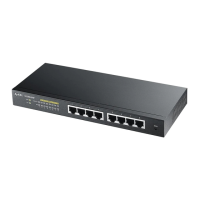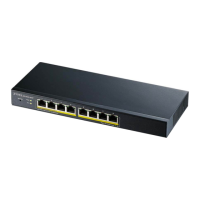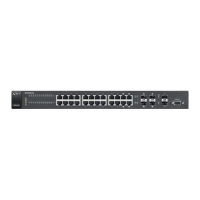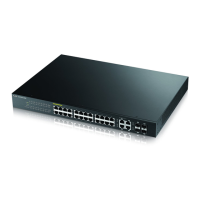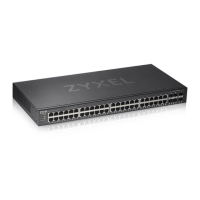Do you have a question about the ZyXEL Communications GS1900-24E and is the answer not in the manual?
Introduces the GS1900 series Gigabit Ethernet Web-Managed Switch.
Shows network environment examples for the switch, including PoE, backbone, bridging, and desktop connections.
Details the methods available for managing the switch, including Web Configurator, TFTP, SNMP, and ZON Utility.
Provides recommendations for secure and effective switch management, including password practices and backups.
Outlines essential safety measures to observe before installing and using the switch.
Describes the different ways the switch can be installed: desktop, wall-mounted, or rack-mounted.
Provides a step-by-step guide for placing the switch on a desktop surface.
Details the requirements and procedure for mounting the switch onto a wall.
Explains the requirements and steps for mounting the switch in a standard EIA rack.
Illustrates and describes the front panel components and connections of various switch models.
Shows and describes the rear panel components of the switch models.
Provides a description of the LED indicators and their meanings for switch status.
Explains how to reset the switch to factory defaults using the reset button for specific models.
Details the process for resetting the switch to factory defaults using the restore button for specific models.
Introduces ZON Utility for network deployment and management, detailing its functions and discovery process.
Lists the minimum operating system and hardware requirements for installing and running the ZON Utility.
Provides instructions on how to run the ZON Utility and check device compatibility.
Introduces the HTML-based management interface for switch setup and management.
Guides on how to access the switch's Web Configurator via a web browser.
Explains the layout of the Web Configurator interface, including the title bar and navigation panel.
Explains how to check status information about the switch using the Getting Start screens.
Describes the initial screens displayed upon login, showing device information and status widgets.
Provides information on viewing general switch settings within the Monitor System section.
Explains how to view IPv4 and IPv6 interface status and management IP addresses.
Details how to view general system information such as system name, location, and contact.
Introduces how to view general switch port settings in the Monitor Port section.
Guides on viewing port status, port counters, and bandwidth utilization.
Explains the Power over Ethernet (PoE) function and related screens for models ending in 'HP'.
Details how to view and configure bandwidth control for incoming and outgoing traffic flows.
Explains how to limit broadcast, multicast, and unicast packets per second on ports.
Explains Virtual Local Area Networks (VLANs) and their role in partitioning networks.
Guides on viewing and configuring VLAN, port, and VLAN port settings.
Details how to configure a guest VLAN for unauthenticated access to limited network resources.
Explains how to configure Voice VLANs for prioritizing voice traffic and ensuring quality.
Describes how MAC tables (filtering databases) show frame forwarding and filtering across switch ports.
Guides on viewing filter static and MAC table settings for the switch.
Explains link aggregation (trunking) as grouping physical ports into a single logical link.
Guides on viewing switch link aggregation status, including LAG and LACP port settings.
Introduces Loop Guard for handling network loop problems on the edge of the network.
Guides on viewing switch loop guard status and port settings.
Explains multicast packet transmission and IGMP protocol for multicast group membership.
Guides on viewing switch multicast features, including VLAN, statistics, group, and router settings.
Introduces Spanning Tree Protocol (STP), RSTP, and MSTP for preventing network loops.
Guides on viewing switch spanning tree settings, including CIST, MST, and STP statistics.
Explains Link Layer Discovery Protocol (LLDP) for exchanging device settings and eliminating mismatches.
Guides on viewing LLDP settings, including statistics, remote information, and overloading.
Provides information on viewing settings and traffic statistics related to security activities.
Details how to configure port security to allow only authorized MAC addresses to pass through a port.
Guides on configuring 802.1X security settings for ports and authenticated hosts.
Introduces how to view management settings on the switch.
Explains how to configure syslog settings for logging filter selection and viewing system logs.
Details how to configure CPU protection and error disable recovery settings.
Provides information on configuring system settings.
Guides on viewing and configuring IPv4 and IPv6 interface status and management IP addresses.
Explains how to set the system time and SNTP server settings.
Details how to set system information properties like system name, location, and contact.
Provides information on configuring general port settings.
Guides on viewing and editing general port settings like status, speed, and duplex.
Details how to configure Energy-Efficient Ethernet (EEE) settings for switch ports.
Explains configuration for Power over Ethernet (PoE) global and port settings.
Describes how to define maximum allowable bandwidth for incoming and outgoing traffic.
Explains how to configure storm control to limit broadcast, multicast, and DLF packets.
Explains Virtual Local Area Networks (VLANs) and their role in network partitioning and performance.
Guides on viewing and configuring VLAN settings, including VLAN ID, name, type, and ports.
Details how to configure guest VLAN settings for limited network access for unauthenticated users.
Explains how to configure Voice VLAN settings for prioritizing voice traffic and ensuring quality.
Describes how MAC tables show frame forwarding and filtering, and MAC address learning.
Guides on viewing static MAC, filtering MAC, and dynamic MAC address settings.
Explains link aggregation for creating logical, higher-bandwidth links by grouping physical ports.
Guides on configuring global, LAG management, LAG port, and LACP port settings.
Introduces Loop Guard for configuring the switch to guard against network loops.
Guides on configuring global and port-specific loop guard settings.
Provides information on port mirroring to copy traffic flows for analysis.
Guides on configuring port mirroring settings for ingress and egress traffic.
Explains how to set up one-time and recurring schedules for time-oriented features.
Guides on viewing and editing time range (schedule) rules for features like PoE.
Explains multicast packet transmission and IGMP protocol for multicast group management.
Guides on configuring IGMP settings including global, VLAN, router port, profile, and throttling.
Introduces Spanning Tree Protocol (STP), RSTP, and MSTP standards for network loop prevention.
Guides on configuring global, STP port, CIST, MST, and STP statistics.
Explains Link Layer Discovery Protocol (LLDP) for exchanging network device information.
Guides on configuring LLDP settings including global, port, local information, and MED policies.
Explains Quality of Service (QoS) for managing network delay and bandwidth.
Guides on configuring QoS settings for ports, queues, CoS, DSCP, and IP precedence mapping.
Provides information on configuring security settings for the switch.
Details how to configure port security to limit MAC addresses and control access.
Guides on configuring 802.1X port authentication for network access control.
Explains how to enable and configure Denial of Service (DoS) attack protection.
Introduces AAA (Authentication, Authorization, Accounting) for managing user access.
Guides on configuring authentication methods like Local, RADIUS, and TACACS+.
Details how to configure RADIUS server settings for centralized authentication.
Explains how to configure TACACS+ server settings for centralized authentication.
Provides information on configuring management settings on the switch.
Guides on configuring Syslog settings for storing and sending logs to an external server.
Details how to configure SNMP settings, including global, community, group, user, and trap settings.
Explains how to configure error disable settings for CPU protection and recovery.
Guides on configuring HTTP and HTTPS modes and authentication methods.
Details how to configure Telnet and SSH access settings for remote management.
Guides on configuring user accounts, passwords, and privilege levels.
Explains how to configure global and profile settings for remote access.
Details the process for upgrading the switch's firmware via server or computer.
Explains how to manage firmware versions, including selecting active and backup images.
Guides on saving switch configurations and log files to a server or computer.
Details how to restore previously saved device configurations from server or computer.
Provides access to configuration files for overwriting startup and backup configurations.
Explains how to reset the switch to its original factory default settings.
Guides on using network utilities like Port Test, Ping, and Trace Route for diagnostics.
Details how to restart the switch from the Web Configurator without physically turning it off.
Addresses issues related to power, hardware connections, and LED behavior.
Provides solutions for problems related to accessing and logging into the switch.
Addresses issues concerning lost configuration settings after restarting the switch.
Lists the information needed when contacting customer support for assistance.
Provides contact details for Zyxel's worldwide corporate headquarters.
Contains copyright information for Zyxel Communications Corporation.
States Zyxel's liability regarding product application, use, and changes.
Provides regulatory compliance information, including FCC and ICES statements.
Information specific to product usage within the USA, including FCC EMC Statement.
Information specific to product usage within Canada, including ICES statement.
Information specific to product usage within the European Union, including CE EMC statement.
| Switching Capacity | 48 Gbps |
|---|---|
| Forwarding Rate | 35.7 Mpps |
| Jumbo Frame Support | Up to 9KB |
| Layer | Layer 2 |
| Switch Type | Unmanaged |
| Power over Ethernet (PoE) | No |
| Packet Buffer Memory | 1.5 MB |
| IGMP Snooping | Yes |
| Weight | 2.2 kg |
| Storage Temperature | -40°C to 70°C |
| Certifications | CE, FCC, RoHS |
| MAC Address Table | 8K |
| Management | Web-based GUI |
| VLAN Support | Yes |
| Quality of Service (QoS) | Yes |
| Spanning Tree Protocol (STP) | Yes |
| Link Aggregation | Yes |
| Power Supply | 100-240 V AC, 50/60 Hz |
| Operating Temperature | 0°C to 50°C |
| Humidity | 10% to 90% (non-condensing) |
| Ports | 24 x Gigabit Ethernet ports |


